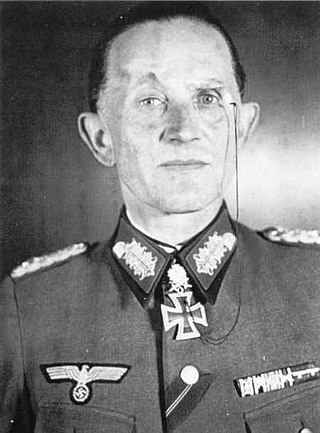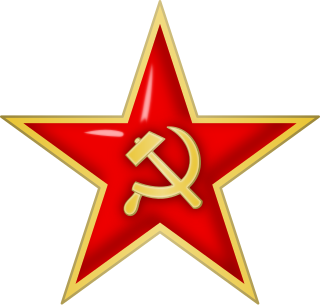Source
Volksgrenadier divisions of the German army, 1944–45 | |
|---|---|
| |
See also: List of German divisions in World War II |
The 548th Grenadier Division was a German infantry division during World War II.
The division was formed in Lithuania on 11 July 1944 and fought on the Eastern Front as part of the XII SS Corps.
On 9 October 1944, the division was renamed the 548th Volksgrenadier Division.
The division fought in the Battle of Memel, in East Prussia and was destroyed during the Samland offensive in the Pillau–Königsberg area in February/March 1945.
Army Group North was the name of three separate army groups of the Wehrmacht. during World War II. Its rear area operations were organized by the Army Group North Rear Area.
The 1st Infantry Division was an infantry division that notably served in World War II as part of the Heer of Nazi Germany's Wehrmacht. It had been one of the original infantry divisions of the Reichswehr.

Dietrich Friedrich Eduard Kasimir von Saucken was a German general during World War II who commanded the 2nd Army and the Army East Prussia. Turning down an offer to escape by air, he surrendered to the Red Army in May 1945. Saucken was the last officer to be awarded the Knight's Cross of the Iron Cross with Oak Leaves, Swords and Diamonds of Nazi Germany.

The 3rd Infantry Division was an infantry division of the German Army that fought in World War II. The division was established under the cover name Wehrgauleitung Frankfurt in 1934 by expanding the 3rd Division of the Reichswehr. It was redesignated Kommandant von Frankfurt shortly afterward, and took on its bona fide name when the formation of the Wehrmacht was announced in October 1935. In March 1939 the division took part in the invasion and occupation of Czechoslovakia.
The XXVIII Army Corps was a corps which served in Nazi Germany's Wehrmacht during World War II. The corps was created on May 20, 1940 in Wehrkreis III. During the war, the corps was subordinated to the German 6th, 16th, 18th, and 3rd Panzer Armies. In 1945, the corps was briefly named Armeeabteilung Samland. The corps fought in Samland until annihilated in late April 1945.

The Battle of Königsberg, also known as the Königsberg offensive, was one of the last operations of the East Prussian offensive during World War II. In four days of urban warfare, Soviet forces of the 1st Baltic Front and the 3rd Belorussian Front captured the city of Königsberg, present day Kaliningrad, Russia. The siege started in late January 1945 when the Soviets initially surrounded the city. Heavy fighting took place for control of overland connection between Königsberg and the port of Pillau, however by March 1945 Königsberg was hundreds of kilometres behind the main front line in the eastern front. The battle ended when the German garrison surrendered to the Soviets on 9 April after a three-day assault made their position untenable.
The Battle of Memel or the siege of Memel was a battle which took place on the Eastern Front during World War II. The battle began when the Red Army launched its Memel offensive operation in late 1944. The offensive drove remaining German forces in the area that is now Lithuania and Latvia into a small bridgehead in Klaipėda (Memel) and its port, leading to a three-month siege of that position.
The 24th Panzer Division was formed in late 1941 from the 1st Cavalry Division based at Königsberg.

The 56th Infantry Division was a German infantry division which fought during World War II.

The 561st Volksgrenadier Division was a division of the Wehrmacht active during World War II. When it was formed in July 1944, it was originally designated as the 561st Grenadier Division.
The 26th Rifle Division was a rifle division in the Soviet Red Army during the Russian Civil War, World War II and the Cold War. The division was formed on 3 November 1918 on the Eastern Front, sent to the Soviet-German Front in August 1941. Ended the war in Poland, where it was assigned to the Northern Group of Forces. It was disbanded in 1952.
The 43rd Army was a Red Army field army of World War II that served on the Eastern Front. Formed in late July 1941, the army fought in the Battle of Smolensk (1941). It was forced to retreat after German troops broke through in October 1941 and subsequently fought in the Battle of Moscow. The army then fought in the Rzhev-Vyazma Offensive. After the end of the offensive, the army held its positions and transferred to the Demidov area in late 1942. It fought in the Battle of Smolensk (1943). During the summer of 1944, the army fought in Operation Bagration. In the fall the army advanced into the Baltic region and fought in the Riga Offensive (1944) and the Battle of Memel. In 1945 the army fought in the East Prussian Offensive before being placed in reserve near the end of April. The 43rd Army was disbanded postwar in July 1946.
The 5th Guards Rifle Division was an infantry division of the Red Army in World War II. It fought at Kaluga, Orel, Moscow, Bryansk, Gorodok, and in Belorussia, East Prussia, and Kurland.
The 67th Anti-Aircraft Artillery Division was an anti-aircraft artillery division of the Soviet Union's Red Army during World War II. Formed in September 1943, the division fought in the Baltic Offensive, the East Prussian Offensive, and the Samland Offensive. It was disbanded after the end of the war.
The 263rd Rifle Division was an infantry division of the Red Army during World War II.
The 262nd Rifle Division was an infantry division of the Red Army during World War II.

The 70th Rifle Division was an infantry division of the Red Army and briefly of the Soviet Army, formed twice.

The 376th Infantry Division was an infantry division of the German Army during World War II, active from 1942 to 1944 in two separate instances.
The 215th Rifle Division was an infantry division of the Red Army during World War II that continued to serve in the Soviet Army during the early years of the Cold War. It was the successor to a motorized division of that same number that was destroyed during the Battle of Kiev in September 1941.
The 367th Infantry Division was a German infantry division in World War II.